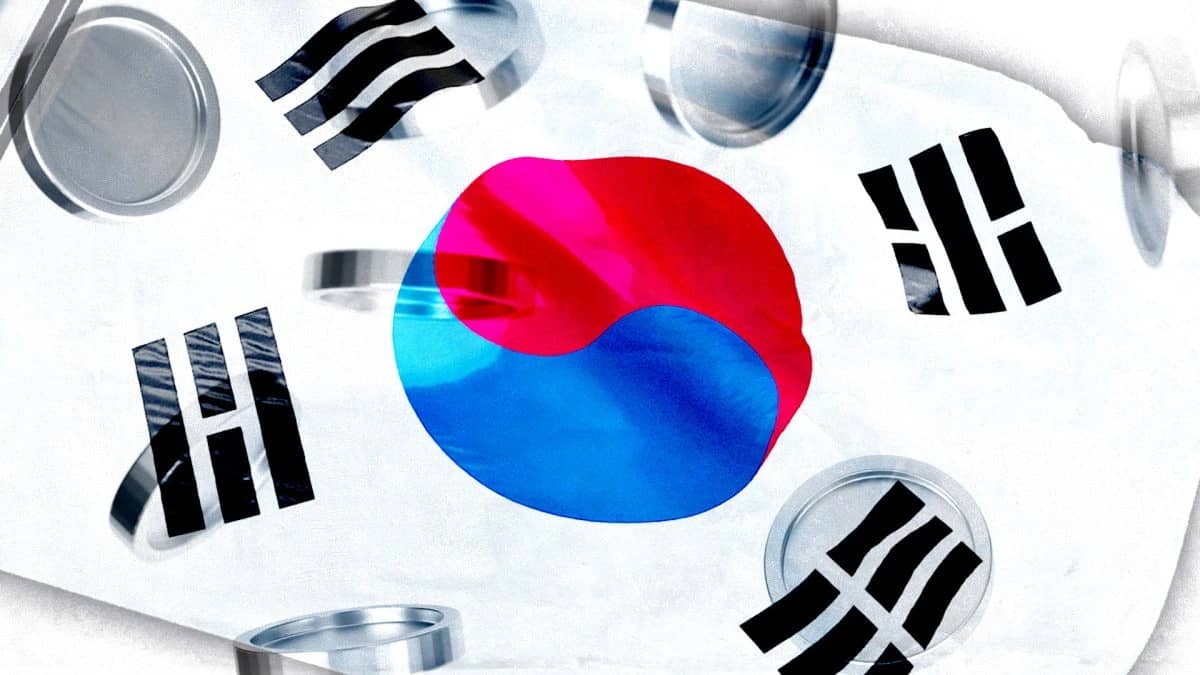订阅 wiki
Share wiki
Bookmark
KRW1
KRW1
KRW1 是一种法币抵押的稳定币,与韩元(KRW) 1:1锚定。该稳定币由韩国数字资产托管公司BDACS发行,在Avalanche 区块链上以概念验证阶段启动,并由韩国一级商业银行友利银行的独立托管账户中持有的韩元储备金完全支持。 [5] [6] [1]
概述
KRW1是由釜山数字资产托管服务公司 (BDACS) 开发的一种“主权对齐、监管就绪”的数字货币,旨在展示完全商业化的韩元 稳定币 的技术和监管基础设施。 [5] [7] 该项目于 2025 年 9 月 18 日推出,此前已成功完成与其银行合作伙伴友利银行的概念验证 (PoC) 验证。在发布时,KRW1 处于试点阶段,尚未公开流通,其使用仅限于技术演示目的,等待韩国的《数字资产基本法》的最终确定,预计将于 2026 年实施。 [6] [2]
KRW1 的推出被定位为韩国受监管的银行集成数字货币的重要一步,仅在 2025 年第一季度,该市场就处理了超过 57 万亿韩元(约 410 亿美元)的 稳定币 交易。 [7] BDACS 为 稳定币 开发了一个全面的框架,包括发行和管理系统,以及支持点对点转账和交易验证的用户应用程序。在 PoC 阶段,流通中的 15,000,000 KRW1 完全由 BDACS 控制的钱包持有,并由公司自己的“自有资本”支持。 [5] 通过在该国正式的 稳定币 立法之前推出,BDACS 在该新兴国内市场建立了早期存在。该项目旨在 利用 友利银行的机构支持及其与全球 区块链 网络的合作关系,为该地区的数字资产市场建立基础架构。 [4]
在一份关于该项目市场地位的声明中,BDACS 指出它具有竞争优势,同时也发出了开放合作的信号:“虽然大型科技公司最终可能会进入市场,但 KRW1 已经在友利银行和全球 区块链 合作伙伴的强大机构支持下投入运营。这种组合提供了大型科技公司无法比拟的基础设施深度。BDACS 将这些公司视为潜在的合作者,而不是竞争对手。” [6] [4]
历史
KRW1 的开发始于基础法律步骤,BDACS 于 2023 年 12 月完成了“KRW1”品牌的商标注册。[6] 随后是技术开发和建立合作伙伴关系,最终与友利银行合作成功完成了对其资金管理系统的概念验证检查,友利银行是 PoC 的积极参与者。此验证确认了用于铸造、管理储备以及实时连接银行系统的技术框架。[5] [6] [3]
KRW1 于 2025 年 9 月 18 日在 Avalanche 网络上正式启动。该公告将 KRW1 定位为由韩国托管机构在主要全球 区块链 上推出的首个韩元支持的 稳定币。此次发布发生在之前已经探索过韩元挂钩稳定币的市场中。2025 年 8 月,fanC 和 Initech 推出了名为 KRWIN 的 稳定币 试点,作为国内 稳定币 领域的先驱。然而,KRW1 的推出因其与主要金融机构友利银行直接整合以进行 储备 托管而脱颖而出。[2] [1] [4]
技术
储备模型和透明度
KRW1被设计为一种完全抵押的稳定币,采用全额储备模式,每个代币都应由等值的韩元1:1支持。法定货币储备金保存在友利银行的一个专门的、隔离的第三方托管账户中。这种结构旨在实现“破产隔离”,确保用户资金免受BDACS运营资本的影响,并且每个KRW1代币都可以兑换成一个韩元。 [7] [1]
为了保持透明度和问责制,该系统采用了一个实时银行API,该API直接连接到友利银行的系统,从而可以即时验证支持KRW1流通供应量的法定货币储备金。对于未来的商业发布,BDACS计划实施一个全面的透明度框架,其中包括每月银行验证的证明、顶级四大会计师事务所的半年一次的独立审计以及用于实时储备验证的面向公众的仪表板。但是,在PoC阶段,不会定期进行正式的证明和审计。 [5] [7]
技术架构
KRW1 最初是在 Avalanche 区块链 上推出的。根据 BDACS 的说法,选择 Avalanche 是因为其高性能、安全性和可扩展性。该平台的可靠性也被认为是关键因素,特别是其在公共部门应用中的潜力,因为它已获得韩国互联网与安全局 (KISA) 的可靠性认可。 [6] [3]
BDACS 开发了其所谓的“全栈框架”来支持稳定币的整个生命周期。该基础设施包括:
- 多链设计: 该架构旨在 跨 多个 以太坊 虚拟机 (EVM) 兼容区块链运行,支持在公共网络和许可机构账本上进行部署。 [7]
- 机构级托管: BDACS 采用 混合 托管模型,结合多方计算 (MPC) 以实现运营安全,并结合气隙冷钱包以实现长期存储。托管基础设施已通过 ISMS 和 ISO 27001 认证。 [5] [7]
- 合规性和用户保护: 在 PoC 期间,通过预先批准的钱包的“允许列表”来管理对 KRW1 的访问。该系统集成了钱包级别的 KYC/AML 执行、自动交易监控以及符合金融行动特别工作组 (FATF) 指南的制裁筛选。智能合约是使用可升级的代理模式构建的,以便进行安全补丁和增强。 [7]
- 代币生命周期: 该过程受到严格控制,首先是对经过验证的实体进行 KYC/AML 入职。法定 KRW 存入隔离的 储备 账户,之后以 1:1 的比例铸造 KRW1 代币并发送到用户的允许列表钱包。赎回涉及将代币发送到销毁地址,这会触发将等值的法定 KRW 释放回用户的银行账户。 [7]
路线图和未来发展
BDACS已声明其计划将KRW1扩展到 Avalanche 以外的其他 区块链 网络,以增强互操作性。 [6] 该项目的路线图分为两个主要阶段:
- 概念验证(2025–2026): 此阶段的重点是验证技术和运营框架,与银行合作伙伴整合,运行实时交易模拟,并准备正式审计。
- 商业发行(2026 年后): 在预计的《数字资产基本法》实施后,BDACS 计划全面公开发布,扩展其银行网络,并与金融科技平台、商家和 DeFi 协议集成。
长期技术目标包括确保 KRW1 与潜在的韩国央行数字货币 (CBDC) 互操作,集成零知识证明模块以实现保护隐私的合规性,并扩展其作为代币化现实世界资产 (RWA) 结算资产的作用。 [7]
使用案例
KRW1 旨在为个人和机构金融领域的广泛应用而设计[5]。
个人用途
- 日常支付: 用于更快、更低成本的零售和在线购物数字支付。
- 旅游: 允许游客使用韩元计价的代币无缝支付,避免高额外汇费用。
- 韩流娱乐: 为音乐、游戏和现场活动的微交易提供动力。
- 汇款: 实现近乎即时的国际汇款,成本低于传统的电汇服务。
面向机构
- 资金管理与结算: 用于管理企业流动性、支付供应商费用以及实时结算交易。
- 跨境支付: 通过直接以KRW1进行交易,降低国际贸易中的货币风险和结算成本。
- 加密资本市场准入: 为交易所提供稳定的KRW交易对,并为DeFi借贷市场提供流动性。
- 资产代币化: 作为发行和结算代币化证券、债券和其他现实世界资产的稳定锚点。
这些用例旨在利用区块链技术的优势来改进传统金融系统。 [5] [7]
治理和风险管理
在其商业阶段,BDACS计划建立一个多层治理框架,以确保稳健的监督和风险管理。该结构旨在包括一个由高级管理人员和银行合作伙伴组成的指导委员会、一个专门的风险与审计委员会以及一个由监管和技术专家组成的外部顾问委员会。 [7]
该项目的风险管理框架涵盖了几个关键领域:
- 网络安全风险: 通过定期的智能合约审计、入侵检测和混合 MPC/冷钱包托管架构来缓解。
- 市场和流动性风险: 通过保持完全的法定货币支持并确保代币供应和银行储备之间的实时对账来解决。
- 监管风险: 通过持续监控不断变化的法律环境以及使用灵活、可升级的合规模块来管理。
- 运营和结算风险: 通过自动交易日志记录、与银行合作伙伴的API级别对账以及灾难恢复计划来控制。
该框架旨在使KRW1与国际稳定币监管的最佳实践保持一致,并建立用户和监管机构的信任。 [7]
主要实体和合作伙伴
多个关键组织参与了KRW1的开发和运营:
- BDACS (釜山数字资产托管服务): KRW1 稳定币的主要发行方和开发者。该公司是一家由首席执行官Harry Ryoo领导的韩国数字资产托管公司。
- 友利银行: 韩国主要的金融机构,作为支持KRW1的法币储备的托管方。该合作关系提供了机构信誉,并确保抵押品的安全持有。
- Ava Labs: Avalanche 区块链背后的开发公司,也是KRW1的初始网络。Justin Kim是Ava Labs的亚洲区负责人。
这些合作关系构成了KRW1生态系统的核心,结合了数字资产、传统银行和区块链技术方面的专业知识。 [6] [1] [3]
监管和市场背景
KRW1 的推出正值韩国数字资产监管环境不断演变之际。预计政府将颁布《数字资产基本法》,并将于 2026 年开始实施,该法将为稳定币的发行和使用提供明确的规则。[7] 李在明政府表示支持开发与当地货币挂钩的稳定币,以增强货币主权。[2]
然而,监管机构对此事表达了不同的意见。韩国央行(韩国的中央银行)主张将当地稳定币的发行限制在获得许可的银行机构,以减轻潜在的金融不稳定和系统性风险。这导致了一种动态的环境,像 BDACS 这样的私营公司在创新,同时也在预测未来的监管要求。[4]
立法程序中,韩国主要政党提出了相互竞争的提案。民主党的法案明确禁止为稳定币存款支付利息,并为发行人设定了 360 万美元的最低资本要求。相比之下,执政的人民力量党的立法不包括利息禁令,而是侧重于许可和披露规则。然而,两项提案都同意需要完全的储备支持和韩国央行加强监督。关于这些细节的辩论突显了决策者面临的挑战。OneKey 的亚太地区区域经理 Rich O. 指出,韩国的稳定币规则需要一种“平衡的方法”,在货币主权和消费者保护之间进行权衡,以防止“过度限制”削弱该国在数字资产领域的竞争力。[3]
韩元支持的稳定币市场也变得越来越有竞争力。包括 Kakao Bank 和 KB Kookmin Bank 在内的九家主要商业银行和在线银行已宣布计划推出自己的韩元支持的稳定币。[7] KRW1 的推出也发生在更广泛的区域趋势中,其他亚洲经济体也在推进自己的稳定币项目。在日本,JPYC 预计将获得监管部门的批准,而 Ripple 和 SBI Holdings 计划在 2026 年之前推出 RLUSD 稳定币。同样,据报道,中国银行香港分行已考虑申请稳定币发行人许可证。[5] [3]
引言
- BDACS CEO Harry Ryoo: "BDACS 不仅仅是一家托管服务提供商。我们正在构建数字资产市场的支柱,为企业、机构和公共部门合作伙伴提供服务。KRW1 标志着我们公司的一个关键时刻,我们有信心它将成为数字经济的基础资产。" [6]
- Ava Labs 亚洲区负责人 Justin Kim: "KRW1 的成功试运行表明,需要一种针对符合监管要求的稳定币量身定制的高性能且可靠的区块链。Avalanche 的技术及其不断增长的现实世界资产生态系统将帮助 BDACS 和友利银行为韩国的数字经济构建一个强大、创新的解决方案。" [6]
- BDACS 声明: "KRW1 目前处于全面 PoC 之后的试点阶段,标志着韩国受监管的、银行集成的数字货币迈出了重要一步。" [5]
发现错误了吗?
